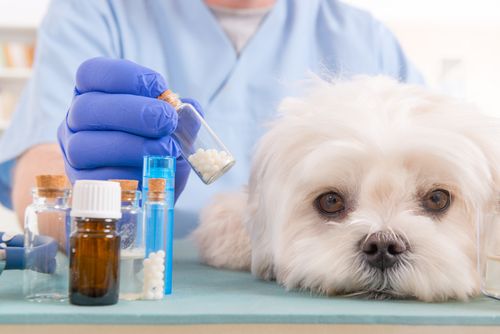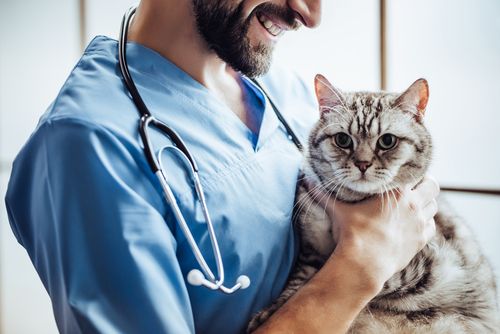
Homeopathy is a medical philosophy and practice based on the theory that by using the correct natural substances, the body can heal itself. Homeopathic remedies are used by more than 200 million people around the globe to treat a wide range of conditions.
The underlying principle is that the same substance that causes symptoms when given in a large dose, could also cure those symptoms if administered in a small dose. The trick is to find the remedy that best matches the symptoms.
Holistic medicines are derived from entirely natural substances such as minerals, plants and animal matter which stimulate the immune system and promote natural self-healing.
Is homeopathy safe for my pet?
While omeopathic remedies are completely natural and safe for the majority of humans and pets, your veterinarian will be able to advise you if there is any reason why homeopathy may not be suitable for your pet.
Homeopathy in animals has had so many success stories that an increasing number of veterinarians are studying, gaining qualifications in, and practicing the principles.
What conditions can homeopathic remedies help to treat?
Homeopathy has had proven results in an extensive range of chronic and acute conditions including:
Digestive and endocrine diseases
Fleas, skin and coat disorders
Heart and kidney diseases
Bone and joint disorders
Ears, eyes, nose and mouth problems
Immune system disorders
Respiratory disease
Mood and behavior problems
Reproductive system problems
Viruses and acute infections
Healing and recovery

Just like humans, pets can have days where they feel a little lethargic or under the weather, but it is a natural instinct of an animal to try and disguise any signs of illness. They do this because in the wild, showing signs of weakness can leave them vulnerable to predators and open to attack. Unfortunately, this can make it tricky to determine if your pet is feeling a little unwell or if they are suffering from a more serious illness.
There are a number of symptoms and changes in your pets’ appearance, behavior and physical condition that you should look out for.
These include but are not limited to:
Abnormal vocal noises
Bloating of the abdomen
Blood in the stools or urine
Decreased energy or activity levels
Diarrhea and/or vomiting
Discharge from the nose or eyes
Excessive scratching or licking of the body
Foul odor from ears, mouth or skin
Increased shedding or bald patches
Limping
Lumps or tumors
Persistent hiding
Reluctance to use stairs
Seizures
Straining or an inability to pass urine or stools
If your pet is showing any of the above symptoms, they should be checked out by a veterinarian within 24/48 hours.
Symptoms that require immediate veterinary treatment include:
Bloated or hardened abdomen
Excessive vomiting or diarrhea
Inability to stand up or urinate
Seizures
While a sick pet may require inpatient treatment from your veterinarian for several days or even weeks, they will often need continuing care to aid in their recovery when they come home. This can include administering medication, supporting physical rehabilitation, emotional care, and fulfilling any special dietary requirements.

We all know that most cats like water as much as we like receiving a letter from the IRS! While they may spend hours grooming themselves to perfection, there are some circumstances where it may be necessary to perform a thorough cleaning of your feline friend which usually makes bathing them unavoidable.
Cats can find being bathed extremely stressful which makes them far more likely to become defensive or even aggressive, causing them to hiss, raise their fur and even lash out at you. However, with some preparation and patience, you can bathe your cat and survive scratch-free. The secret to this involves not so much a bath, but a shower instead!
Get Organized
Just like bathing a baby; bathing a cat requires everything that you need to be within arm’s reach.
You should have:
A shower or bath with a handheld showerhead.
Several towels to clean her off and help her dry.
Specialty cat shampoo and conditioner which is available from most pet stores. Additionally, your veterinarian will be able to tell you if there is a particular type that would be best for your feline friend. Just remember, you should never use human shampoo or conditioner as is has a different PH level to the sort suitable for cats and could damage your pet’s hair or skin.
Pre-bathing Prep
Before you begin, you should brush your cat to remove any knots or tangles, particularly if she is a long-haired breed. Set the water temperature to warm and have it running through the showerhead at a medium level spray.

As Spring warms up into Summer and the humidity and heat start to really set in, it's good to remember that, like every other member in your family, you need to take extra care with your pet. When the weather begins to heat up, it is easier for you to become dehydrated and dangerously overheated, which can result in falling unconscious, vital organ damage, or even death. The same is true for your pets!
We tend to think of animals as hardier than humans, but the truth is, dogs and cats begin to experience heatstroke (hyperthermia, medically speaking) at the same internal body temperature as humans do — 104° F, with severe heatstroke beginning at 105° to 106° F internally. It might be more difficult for you to gauge temperature with smaller pets such as hamsters, but there's one rule of thumb to keep in mind: always watch the heat index. Meteorologists use the heat index value to determine what the temperature is once humidity is applied and it's this balance of heat and humidity that is dangerous to the health of you and your pet.
Starting when the heat index is 90° F, you need to be sure to take precautions to protect your pets. They won't be able to ask you to turn on the air conditioning or for extra water and they won't be able to tell you when they're starting to feel ill. Your pets depend on you to responsibly monitor the weather and give them what they need to stay healthy and comfortable.

Keeping your pet safe is the most important part of keeping both you and your pet happy. When you first adopt a pet or new breed of pet — or even better, before you adopt them — be sure to research the basics of your pet. When you finally select a pet, talk to the shelter staff about things you might need to worry about or watch out for. Of course, you can always stop by with your pet to discuss behaviors, concerns, or anything else.
Below we've got some general notes on basic safety tips, whether indoors or outdoors. Remember that traveling —that's more than a quick jog to the park or a ride across town for a play date— may require some extra steps based on the species of your pet. Traveling at any distance can give some pets anxiety, and there are other physical safety factors to consider. Come by and talk to us about what you may need, especially if you're about to travel abroad!










